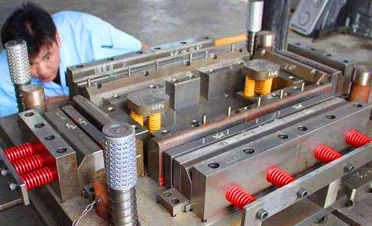hot stamping parts
Hot Stamping Parts An Overview of the Process and Applications
Hot stamping, also known as hot forming, is a manufacturing process that involves shaping metallic materials at high temperatures to enhance their performance in various applications. This technique has gained significant traction in the automotive and aerospace industries, where the strength-to-weight ratio is crucial. Hot stamping parts provide a unique combination of excellent mechanical properties while maintaining lightweight characteristics, making them ideal for modern manufacturing needs.
The Hot Stamping Process
The hot stamping process begins with heating a steel blank, often made from boron-alloyed steel, to a temperature of around 900°C. This high temperature increases the material's ductility, allowing it to be easily formed into complex shapes. Once heated, the blank is quickly transferred to a stamping die, where it is formed under high pressure. The application of pressure at elevated temperatures allows the material to be shaped accurately without cracking or breaking.
After the stamping process, the part undergoes a rapid cooling process known as quenching. This involves the use of water or air to cool the hot stamped part, resulting in a significant increase in hardness and strength. The transformation from austenite to martensite during cooling yields a final product with exceptional mechanical properties, often exceeding the capabilities of cold-stamped materials.
Advantages of Hot Stamping
One of the primary advantages of hot stamping parts is their remarkable strength. Parts produced through hot stamping can achieve tensile strengths exceeding 1500 MPa, making them suitable for high-performance applications. This strength is particularly beneficial in the automotive industry, where vehicle safety is paramount. Components such as chassis beams, roof pillars, and crumple zones made through hot stamping can absorb significant energy during collisions, enhancing occupant protection.
Additionally, hot stamping allows for more intricate designs compared to traditional stamping processes. Manufacturers can create lightweight but complex geometries that are difficult to achieve with other techniques. This capability is vital in industries where weight reduction is essential for improved fuel efficiency, such as in electric vehicles.
Applications of Hot Stamping Parts
hot stamping parts

Hot stamping parts have found extensive applications in several industries. In the automotive sector, they are used to produce structural components that require high strength and durability. For example, manufacturers employ hot stamping to produce parts for vehicle safety systems, such as A-pillars and side impact beams. The ability to achieve complex shapes without compromising strength makes these components ideal for modern vehicle designs.
Moreover, hot stamping is gaining traction in the aerospace industry. Aerospace components often demand lightweight materials with superior mechanical properties. Hot-stamped parts can be utilized in critical applications such as aircraft frames and engine mounts, where performance and reliability are of utmost importance.
The construction industry is also beginning to recognize the benefits of hot stamping. Structural components made from hot-stamped steel offer enhanced load-bearing capabilities and resistance to environmental conditions, making them suitable for demanding applications.
Future of Hot Stamping
As industries continue to evolve and the demand for lightweight, high-strength materials increases, the future of hot stamping looks promising. Ongoing research and development in material science and process technology aim to enhance the efficiency of hot stamping operations. Innovations such as hybrid manufacturing processes, where hot stamping is combined with other forming techniques, are emerging to further optimize production capabilities.
Additionally, advancements in automation and control systems can significantly improve the precision and speed of the hot stamping process, allowing manufacturers to meet the growing demand for high-quality components quickly and cost-effectively.
Conclusion
Hot stamping parts represent a pivotal advancement in manufacturing technology, offering exceptional strength, lightweight properties, and design flexibility. As industries seek to create safer and more efficient products, hot stamping will undoubtedly play a crucial role in the future of manufacturing, paving the way for innovations that meet the evolving needs of society.
-
OEM Sand Cast Pump Valve Fittings - Baoding Hairun | Precision Engineering, CustomizableNewsJul.30,2025
-
OEM Sand Cast Pump Valve Fittings - Baoding Hairun Machinery And Equipment Trading Co., Ltd.NewsJul.30,2025
-
OEM Sand Cast Pump Valve Fittings - Baoding Hairun Machinery And Equipment Trading Co., Ltd.NewsJul.30,2025
-
OEM Sand Cast Pump Valve Fittings - Baoding Hairun Machinery|Precision Engineering&Fluid ControlNewsJul.30,2025
-
OEM Sand Cast Pump Valve Fittings - Baoding Hairun Machinery And Equipment Trading Co., Ltd.NewsJul.30,2025
-
OEM Sand Cast Pump Valve Fittings-Baoding Hairun Machinery And Equipment Trading Co., Ltd.NewsJul.30,2025















